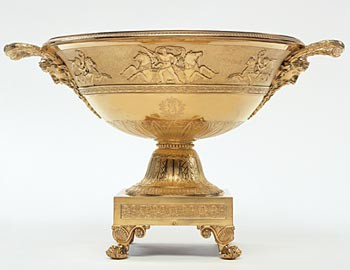The word “punch” comes from the Persian word for “five”, so-called because the drink was composed of five elements: tea, sugar, rum or distilled spirit, cinnamon and lemon. The resulting mixture was put in a bowl, usually made of gold or porcelain, and served in tea-cups with special spoons. Every silver or vermeil table service would have a punch bowl, and Josephine's, produced by the goldsmith Martin-Guillaume Biennais, was no different. The punch bowl is gilt-silver, and comprises a large cup resting on a small bell-shaped pedestal, with a square base supported by feet in the form of an animal paw. On the base is the signature “BIENNAIS ORF.re de L.L. M.M. IMPERIALES ET ROYALES A PARIS”. Just above the laurel border on the bowl is a design, in bas-relief, of a youthful Neptune driving his sea-horses. He is flanked by winged putti, bearing crowns and either on horseback (left) or on the back of a bull (right). The handles are mounted on the bowl in a bearded-man design. Josephine's crowned insignia is engraved on the belly of the cup.
Josephine's punch bowl, which came with three spoons, was kept at Malmaison in a room below the library, along with her other items of gold. Following her death, one of the spoons went to Eugène, whilst the other two and the bowl were passed down to Hortense. The bowl reappeared in her bedroom at her home in Konstanz where she spent the early years of her exile. It was not unusual to find such an item in the bedroom, a common practice being to take a draught of punch before going to bed, thus ensuring a calm and gentle sleep.
In September 1827, the punch bowl was transferred to Italy after Hortense began renting a first-floor apartment in the Ruspoli palace. Any trace of it was lost after this point, until it reappeared at auction in 1981 and was purchased by Martial Lapeyre. Biennais also produced similar items, including one which forms part of the Emperor's tea service (held in Edinburgh, National Museums Scotland), and another from a service belonging to Grand-duke Nicholas Pavlovitch, the future Tsar Nicholas I.
Bernard Chevallier (tr. & ed. H.D.W.)
Conservateur général du patrimoine (emeritus)
November 2009
Josephine’s Punch Bowl
Artist(s) : BIENNAIS Martin-Guillaume

- Date :
- Between 1805 and 1810
- Technique :
- Gilt-silver
- Dimensions :
- H = 25.5 cm, L = 32 cm
- Place held :
- Paris, Fondation Napoléon
- Photo credit :
- © Fondation Napoléon - P. Maurin-Berthier

